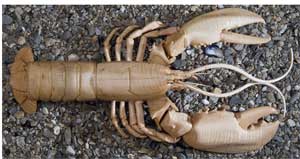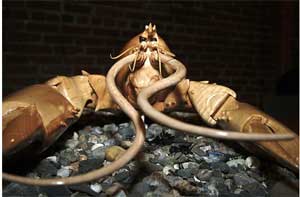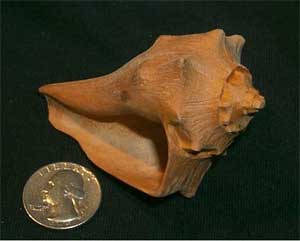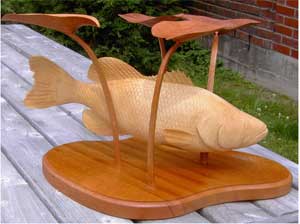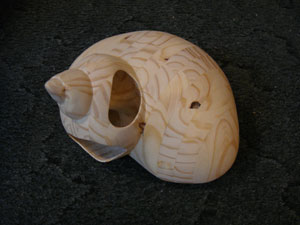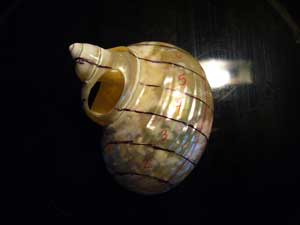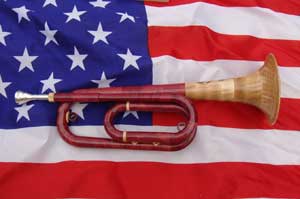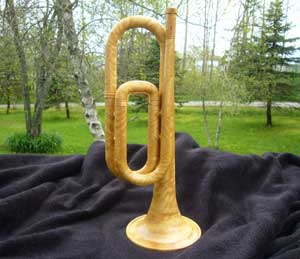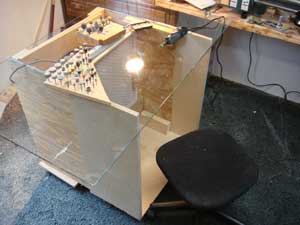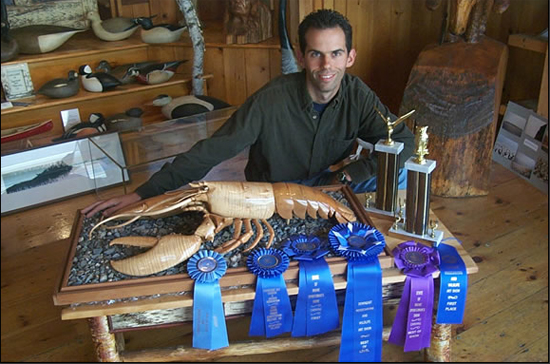
A few years ago, Rob Jones might have been in the same boat as a coworker who came in and began talking about a tree that had come down in his yard and, when split for firewood, “looked just like ribbon candy.”
Luckily, he knew enough about wood and woodworking at that point to recognize something good when he saw it: he filled his Honda Civic with firewood and traded with the coworker — for five sticks of the high grade curly maple. (“He didn’t want to part with it. He wanted it for the firewood,” Rob explained.)
With those five sticks, Rob carved a lobster, “for the challenge.” It followed on the heels of his first carving project, a lobster claw chosen because it was something that “tourists might buy” – in Maine, where Rob lives, “tourists are the only ones with money,” he says.
He moved back to Maine a few years ago after a stint in the Navy. Rob’s original motivation for joining the Navy had been to get money for art school through the GI Bill, since he’s been drawing his whole life, but marriage and kids “put the kibosh on college stuff.” Instead, when he moved back to Maine, he got a job as an electromechanical technician and ended up daily using tools that could also be used for woodworking — an area where he has no educational background.
“Using those tools piqued my interest,” Rob said, and he decided to try out woodworking with the lobster claw project, a belt sander, and a Dremel rotary tool “with a few little bits.” “I’d never seen anybody else’s woodcarving before, but I ended up with a perfect claw, and I thought ‘I can do this.'”
A year and a half later, after carving the lobster — some of it during a car ride (his wife was driving), while Rob sat in the passenger seat and used a needle file and tiny blades — he entered the woodcarving competition, something else he’d never head of, at the Maine Sportsmen’s Show, and went home with both best in show and people’s choice awards. “I was hooked from that point on,” Rob said.
Although he has entered more competitions since that time, and learned about woods like basswood and tupelo, Rob thinks his background lacking in formal woodworking knowledge and training has made him more innovative. He cites as a personal hero the early 20th century Ohio woodcarver Ernest Warther, and quotes him as saying, “I know little of the rules of woodworking, so I’m free to violate them.”
In Rob’s case, one way that attitude has manifested itself is in his choice of wood: he prefers to carve with woods like curly maple, cherry and other traditional woods. One of his few basswood carvings was a bass fish made as a wedding present for a bass fisherman at the request of the man’s fiancee. “I thought it would be funny to carve a bass out of basswood,” Rob said. “Of course, I couldn’t bring myself to do just a simple carving. I spent hours doing the scales so they were just absolutely perfect.”
Many of those hours were spent carving in his recliner chair while watching TV, using a chisel set that “you got a set of six for $20. I took one chisel and sharpened it really good, and had a chisel, an X-Acto® knife, and some sandpaper, and I did all the scales.”
In addition to his unusual carving locations, Rob has created what he calls a “slice” technique for his creations. “You take a seashell, like a spirally conch, and use a Dremel cutoff wheel to slice it into quarter-inch layers.” Then, using his drawing skills, Rob creates what look “almost like MRI drawings” to transfer the pattern into wood. He uses standard thickness lumber, precuts layers into the stock, and then carves an exact replica of the shell design.
When finished, Rob says, he can put a seam down the middle of the wood carving and hold it together with a dowel peg. When opened, you see the entire shell, “carved inside and out. When you hold it up to your ear, it does that effect where it makes that sound” sometimes compared to the ocean.
It was the development of this technique that led Rob into his latest woodworking endeavor: musical instruments. “I saw a brass instrument in the shape of a bell, and I thought, ‘Holy cow, that would be a piece of cake with this technique I’ve learned,'” he said. At a music shop, he saw a French horn and, because “I always seem to gravitate to the most complex thing to try,” he rented the French horn for $60 a month. Rob finished building his first wooden French horn in two months — the rental cost for his model was a motivating factor.
“I thought, ‘The first question somebody’s going to ask is, ‘Is it playable?'” Rob said. He had done his best to make the inside hollow, with the outside at perfect dimensions, and the French horn is playable — although Rob describes it as “quiet” and “bad sounding.”
That was merely motivation to improve: now, Rob is building wooden instruments on perfect pitch, including a trombone and his current commission, bugles.
Rob himself plays only the banjo (yes, he built one for himself), but he has others help him create YouTube videos, posted under the user name 58scallop, of his completed projects being played. (One of the buglers who has placed a commission, for a replica of President Kennedy’s funeral bugle, has played “Taps” at Arlington National Cemetery thousands of times.) A lot of variables go into the instrument building, including that, “because wood is more flexible, it absorbs a lot of extra resonant frequencies,” Rob said. “You end up with more of a pure tone.”
Right now, Rob’s mostly concentrating on the musical instruments, with a goal of making woodworking his full-time business in the next three to five years. “I can work all day [on woodworking] without eating, and work until two in the morning until I realize I have to get up and go to work at 6:30 in the morning. I’ve only been making instruments for two years, and carving for 10 years, and I’m only 36 years old. I can’t wait to see what will happen in the future when the shackles of time are taken away and I can go full throttle on this.”
Meanwhile, Rob’s making innovations in his shop, too. Although most of his tools are “the cheapest stuff,” including a band saw, a belt sander and a recent purchase of a machinist’s lathe, he also bought a CNC router with the profits from the $8,000 sale of his carved lobster. He’ll use it rough out his seashells, then make their detail carvings with a Dremel rotary tool. “I’ve gone through five Dremels,” Rob said. “And how I use it is unique. I use my knee as a workbench and rest my hand on my knee and the piece I’m carving on my knee.”
He’s able to do this because of the “hodgepodge dust collector” he created with scrap plywood, a floor fan, a high efficiency furnace filter, and an old computer chair. The dust collector rolls on wheels, and Rob can sit in the chair and power carve, using his knee as a steady-rest while looking down through the glass. The fan sucks any dust into the filter so he doesn’t have to wear a dust mask or safety glasses, “and I have a big glass surface to put my tools on.”(When he’s not using this apparatus, he wears a double-sealed respirator.)
He also enjoys showing his works and his works in progress to people. “A motivational tool for myself is the reactions I get from people when I show them my stuff. It’s so much fun to see the reactions. It fires me up.”
